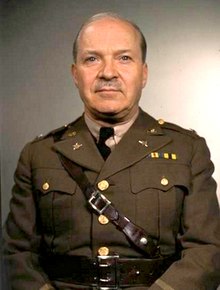Wade H. Haislip
| Wade H. Haislip | |
|---|---|
 |
|
| Nickname(s) | "Ham" |
| Born |
July 9, 1889 , Virginia, United States |
| Died | December 23, 1971 (aged 82) Walter Reed Army Medical Center, Washington, D.C., United States |
| Buried at | Arlington National Cemetery |
| Allegiance |
|
| Service/branch |
|
| Years of service | 1912–1951 |
| Rank |
|
| Unit |
|
| Commands held |
85th Infantry Division XV Corps Seventh Army Vice Chief of Staff of the United States Army |
| Battles/wars |
Pancho Villa Expedition World War I World War II |
| Awards |
Distinguished Service Medal (4) Legion of Merit Bronze Star (2) |
| Other work | Governor, Soldiers Home |
General Wade Hampton Haislip (July 9, 1889 – December 23, 1971) was a senior United States Army officer who served in both World War I and World War II, where he led the XV Corps in the campaign in Western Europe from 1944 to 1945. He later became a four-star general, serving as Vice Chief of Staff of the United States Army (VCSA) from 1949 to 1951.
Haislip was born in on July 9, 1889, and moved at age 2 to Staunton, Virginia. He was commissioned a second lieutenant of infantry upon graduating from the United States Military Academy at West Point in 1912.
Haislip served in Vera Cruz, Mexico in 1914 after the Tampico Affair. From 1917 to 1921, he served with the American Expeditionary Forces, first in World War I, then in the occupation of Germany. During his time overseas his assignments included being on the General Staff of V Corps; Division Machine Gun Officer for the 3rd Division, and General Staff, U.S. Forces in Germany. During World War I he participated in the Battle of Saint-Mihiel and the Meuse-Argonne Offensive. He returned to West point as an instructor from 1921 to 1923. He next attended a series of schools, beginning with the U.S. Army Infantry School from 1923 to 1924, then the Command and General Staff School from 1924 to 1925, and finally going back overseas to attend the French Ecole Superieure de Guerre from 1925 to 1927. He returned to the United States as Assistant executive in the Office of Assistant Secretary of War from 1928 to 1931, followed by the Army War College from 1931 to 1932, and an assignment as an instructor at the Command and General Staff School from 1932 to 1936.
...
Wikipedia
